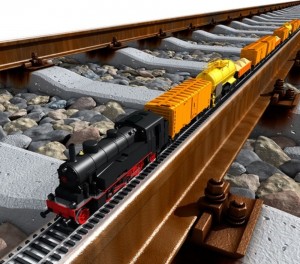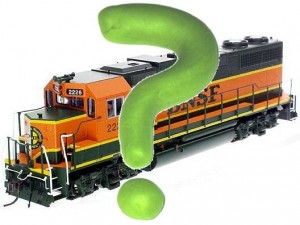Model Trains
Everything on model trains, model railroads, model railways, locomotives, model train layouts, scenery, wiring, DCC and more. Enjoy the world's best hobby... model railroading!
John has a question for knowledgeable readers:
“I recently purchased two Traing engines on e-bay, which included smoke units, and purchased the smoke fluid. Unfortunately I am not having any luck producing smoke. Possibly the heaters are not working. They are old engines so I am unable to get replacements. Any ideas from readers for where I can get any advice or help would be appreciated please.”
Click to add your comment or answer to John’s posting.
 Collecting antique model trains helps you to build an exclusive collection of trains that no one else have but it is not as easy as collecting brand new trains. Do not collect antique trains randomly but choose something that has historical importance to add value to your collection.
Collecting antique model trains helps you to build an exclusive collection of trains that no one else have but it is not as easy as collecting brand new trains. Do not collect antique trains randomly but choose something that has historical importance to add value to your collection.
In many instances, it is difficult to find antique model trains with a fair price quoted but be aware of the fact that paying too much for a train with the idea of re-selling them is not smart because you can’t predict the future but what you can predict is the present and whether the price quoted is appropriate or not.
Larry has a question for others in the hobby and asks:
“Recently I was given an HO DCC F7 engine (Bachmann item # 60135). All of my other engines are DC. Can I run DCC on a layout that is set up for DC? (I was a modeler many years ago. After many moves, two kids and other reasons, I am starting back into the hobby and plan on DC operation for now.)”
Add your comment or answer to this post.
 If you are new to model trains, consider investing in diesel locomotives as some in hobby claim they run better than similarly priced steam engine counter parts. Others in the hobby might disagree. You have the option of cargo and passenger cars, with complete kits available.
If you are new to model trains, consider investing in diesel locomotives as some in hobby claim they run better than similarly priced steam engine counter parts. Others in the hobby might disagree. You have the option of cargo and passenger cars, with complete kits available.
The rails come in various options, but many prefer nickel silver as it ensures better conductivity.
Scenery can be a big investment if you don’t make most of it yourself… it’s fun making scenery!
Always invest in the best engine as you can, and then go on to build the required landscape. The idea here is to create a perfectly running model railroad, otherwise all your efforts on creating a classic model might go in vain.
There are several excellent resources available for beginners (and experienced) hobbyists, including the “Best Selling” Model Train Help Ebook. Model train enthusiasts can also benefit greatly from access the numerous resources inside the online Model Train Club.
 If you have a model railroad question you would like answered, then use the link on this blog to submit your question. If you word your question carefully and provide some useful details, then chances are someone reading this blog will offer a solution. Only the best question will be published. Please spell check your question before submitting it to the blog moderator for approval.
If you have a model railroad question you would like answered, then use the link on this blog to submit your question. If you word your question carefully and provide some useful details, then chances are someone reading this blog will offer a solution. Only the best question will be published. Please spell check your question before submitting it to the blog moderator for approval.
The link to submit your question is on this page.
This poor fellow struggles to share some model train tips he found… thanks to an unhelpful member of the household.
This is very funny, yet kinda sad. Worth sharing.
Add your comments.
 Freight cars are used for the transportation of goods and other bulk commodities. There are six categories of freight trains: gondolas, hoppers, tank cars, well and spine cars, boxcars, and the common flatcar. These trains switch between stops according to two methods: through freight and way freight.
Freight cars are used for the transportation of goods and other bulk commodities. There are six categories of freight trains: gondolas, hoppers, tank cars, well and spine cars, boxcars, and the common flatcar. These trains switch between stops according to two methods: through freight and way freight.
In the through freight method, a switch list is maintained, which defines the train schedule. Trains wait on their designated tracks before arrival and departure. Switching through way freight is complex process. The switch list is very detailed, and defines each car added to the way freight and its location in the train.
Ryan has put together this helpful tutorial for avoiding derailments on a model train layout. The video includes some excellent layout scenes. Feel free to pass it on to friends. Enjoy!
Tim has a question for readers:
“I know you guys know! What’s the older of the freight cars made by Varney the blue/white box RTR or the red and white box RTR 100,000 miles scale? I can find anything about dates online. Thanks”
Gary sent in these photos of a WWI tank train and wondered if anyone knew anything about this type of model:
“I have been searching for information about a Military Lionel Locomotive with 2 cars. I have attached a couple of photos I took of the train. It was my wife’s grandfather train when he was a boy I have no history and cannot find any information about the train. The tank locomotive has a light that flashes as the turret moves back and forth. I’d would appreciate it if someone might be able to provide more information on this model. There is no serial or model number in the electric motor except information about Lionel. ”
Flywheels
Flywheels will generally make your loco run more smoothly. Flywheels will help overcome the effects of dirty spots on the track. They help provide momentum to your loco with starting slowly and stopping slowly or when coasting.
Can Motors
Can motors provide the benefit of being sealed to protect from dirt and dust. As well as that, Can Motors give higher torque with low speeds, and typically are smoother, and will draw less current.
All Wheel Pickup
Having all wheel pickup provides smooth operation and aids operation through crossings, turnouts, and over dirty track. The wheels can provide energy on track and create momentum.
Add your suggestions by clicking the BLUE “Smoother Running Locomotives” title above.
Gary asks readers for advice:
I have a Hornby tender drive Flying Scotsman. The problem is that the 8 wheel tender derails regularly. Never the same position on the track, it appears random. It goes through points with no problem then derails on the curve or even on the straight. The affected wheelset is the last one. It derails when running light engine and when hauling coaches. I have checked the wheel back to back dimensions and they seem OK. Before I throw it as far as I can, does anyone have a solution?
Comment below.
Bill has a question for other hobbyists and ask:
"Does anyone know of a manufacturer that makes Cammelback locos in N gauge --- Besides me??"
Add your answer below.
Note: Camelback locos are also called the Mother Hubbard, or a center-cab locomotive. It is a type of steam loco with its driving cab positioned in the middle - astride the boiler. The Camelback was fitted with a wide firebox which restricted the driver visibility as opposed to the regular cab location at the rear.
Charles is into HOn30 and would like advice from others:
“Has anyone had any experience in designing, producing, using 3D Rapid Protyping of Locomotives and rolling stock in HOn30?”
Add your suggestions below.
Neil would like some help if you have a Flying Scotsman train or understand the workings of running gear:
“My son’s Flying Scotsman lost a hex screw from one side of the running gear recently (it is 3 months old). Returned to the shop for repair under warranty. It runs but seems to me to waddle or fish-tail, especially at slow speeds. It does this forward and reverse. Should it do this? I think the running gear left and right are out of sync with each other. Should they be in sync? Seems to me the wheels on one side have rotated leaving the drive for the left and right sides out of step. I think this could have happened when the hex screw came off while running. Any help appreciated.”
Add your suggestions below.
Double heading (two locos pulling a train) was used to provide the power to pull heavy loads, climb gradients or meet a tight schedule. With steam trains, each engine was operated individually by its own crew, which took skill, cooperation and concentration to avoid wheel slipping which could stall a train or cause a derailment.
Double heading with diesels is different because all the locos working in multiple are controlled by the driver in the cab of the leading engine.
Double heading is always fun to watch especially on a model train layout, and especially with smoke unit equipped steam locos from yesteryear (enjoy the video!).
Double heading (two locos pulling a train) was used to provide the power to pull heavy loads, climb gradients or meet a tight schedule. With steam trains, each engine was operated individually by its own crew, which took skill, cooperation and concentration to avoid wheel slipping which could stall a train or cause a derailment.
Double heading with diesels is different because all the locos working in multiple are controlled by the driver in the cab of the leading engine.
Double heading is always fun to watch especially on a model train layout, and especially with smoke unit equipped steam locos.
A reader asks:
As most model railroaders have TOO many Locomotives and Cars. It would be interesting to know what the recommendation would be for the following -
How many locomotives per sq. ft of Layout? How many Cars per sq. ft. of HO Layout?
Submit your answer below this posting.